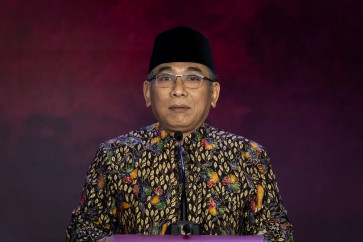Popular Reads
Top Results
Can't find what you're looking for?
View all search resultsPopular Reads
Top Results
Can't find what you're looking for?
View all search resultsBatik: A living heritage
From the depths of dimly lit workshops, hazed by Java’s humidity and smothered by vapors of molten wax, comes the universal language -- batik
Change text size
Gift Premium Articles
to Anyone
F
/span>From the depths of dimly lit workshops, hazed by Java’s humidity and smothered by vapors of molten wax, comes the universal language -- batik.
The art form has documented Indonesian history, culture, landscapes, religion and society on exquisitely dyed pieces of cloth for centuries.
Yet the laborious task of spending up to year using canting, a fountain pen-like tool to apply liquid wax to a cloth, transcends time and space.
The imprints of patience and intimacy that batik artists leave on their work are manifestations of humanity as much as they are manifestations of Indonesia.
Along with the Clean Batik Initiative, JERIN — a project platform put forward by the German Embassy in Jakarta, the Goethe-Institute Jakarta and the German-Indonesian Chamber of Industry and Commerce — are sharing this message in a batik exhibition at the Galeri Nasional Indonesia this month.
The ongoing “Indonesian Batik: A Living Heritage” exhibition journeys through the art form’s history and into its future, embedded in a global community.
It outlines the traditional and almost forgotten production processes and provides an insight into the meaningful symbols and motifs of batik.
It also pays homage to the works of the late batik master, Iwan Tirta, and features European batik artists, whose works are the latest examples of batik’s influence on European art.
“Batik is the peak of art,” said the German-Indonesia Chamber of Industry and Commerce (EKONID) deputy managing director and exhibition coordinator Martin Krummeck.
“We want to bring batik to the world and explain the story behind it.”
Berlin-based batik artist Joachim Blank is one of the seven European artists featured in the exhibition. He is doing precisely as Krummeck says.
Blank became fascinated in the natural dye methods of batik while traveling extensively through Southeast Asia between 1985 and 1992. After learning the craft in Yogyakarta, he began appropriating its core elements, while adding a uniquely European flavor.
Blank’s experimental technique sees him using materials in their natural form, as opposed to a specially carved canting, to etch the cloth.
“I am inspired by nature. I use pieces of wood, which I find at the beach or in the forest. I don’t carve them, I just use them like I see them.”
The product is more abstract than traditional batik, depicting a connection with the environment through the materials used, more than through delicate patterning and motifs. Blank pays particular attention to how materials such as cotton and silk have different structures, so that they give rise to different textures and allusions of depth.
For example, the wooden batik stamp used in his Red Roof piece sees a rectangular shape created, and the burned red and orange dyes given a more vivid grain.
While batik has lead to Blank calling Indonesia his second home, the Indonesian art community has expressed intrigue toward his self-proclaimed “strange” technique. He has been invited to hold workshops for three weeks before returning home in April.
“This is curious because I’m a German and I come to Indonesia to teach Indonesian students batik,” said Blank.
Despite the curator and University of Mainz lecturer’s local successes, he recognized that batik was still a misunderstood concept in Germany.
“This is something like a craft, and craft is a poor art in Germany. Nobody is interested in attending a batik exhibition. It is exotic, it’s not like a painting or sculpture, or ‘real art’ so to speak.”
Blank is eager to bridge this gap, even if it takes controversially painting a Mercedes-Benz with batik patterns.
The German ambassador in Indonesia, Norbert Baas, is confident that batik provides a perfect platform to strengthen ties between Indonesia and Germany.
“There can hardly be anything more colorful, imaginative and refined in Indonesia’s traditional arts than batik. Its inspiration from nature, a kind of sustainable creativity, constantly renewing itself, is the most wonderful trademark for Indonesia.”
The celebration of 60 years of diplomatic relations between the two countries began in October last year, and would only continue with the Living Heritage exhibition.
“Batik is something that is developing all the time. There is nothing stagnant about it. It is done by people who are inspired by their environments,” said Baas.
He was proud to see batik added to the UNESCO Intangible Heritage of Humanity list in 2009, and a section of the exhibition dedicated to the Clean Batik Initiative.
The Initiative is a four-year (2010-2013) program implemented by EKONID, the German-Malaysian Chamber of Industry and Commerce and the IHK-Academy Munich. It is co-financed by the European Commission. A total of ¤2.2 million have been allocated to promote the sustainable production and consumption of batik.
Krummeck recognized that chemical dyes were still being thrown into waterways, and unsustainable resources such as gas and petrol were being used in the batik distribution process.
The exhibition’s Clean Batik Initiative section aims to inform people of a greener future for batik.
Nonetheless, in the spirit of a timeless art form, these forward-thinking projects are juxtaposed next to more antique versions of batik.
A “Pagi-Sore” cloth caught the eye of ceramics artist Gillian Arnold at the opening ceremony. It depicts intricate patterns and images representing the change from morning to evening.
“It’s just the quality of the dotting. Every piece of it is so fine,” said Arnold.
“The artist must have applied around 10 dyes to make all the shades of peach and purple.”
The collection of the APIP Kerajinan Batik founder, Afif Syakur, makes up 80 percent of the works on display. A tribute to the late batik legend Iwan Tirta also sees 33 of the country’s finest works displayed.
Iwan’s contemporary lavishness, coupled with his traditional designs, finds him in magazines such as Vogue, The New York Times and National Geographic.
It is in this vein that fashion designer Musa Widyatmodjo noted how the exhibition, “shows how rich our heritage is, and how there’s an optimistic future for batik”.
“Batik has been used by many designers in the fashion world. It’s a challenge for us to try to use our textiles more in the modern world, rather than just in ethnic fashion. Every part of the world can appreciate batik. It will stay alive while there is need and demand.”
Batik illustrates local, social structures and the stages of life: pregnancy, circumcision, engagement, marriage and eventually, death.
Time passes, social geography changes and batik evolves. Art is as fluid as its influences and the “Indonesian Batik: A Living Heritage” exhibition is an engaging reminder of this.
The writer is an intern at The Jakarta Post.
“Indonesian Batik: A Living Heritage”
Galeri Nasional
Jl. Medan Merdeka Timur 14, Central Jakarta
Runs until Feb. 19
Opens from 10 a.m. to 5 p.m.
Pendapi Gede
Surakarta City Hall, Central Java
Runs from Feb. 29 to March 10










